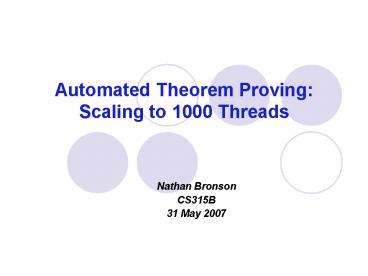Automated Theorem Proving: Scaling to 1000 Threads PowerPoint PPT Presentation
1 / 10
Title: Automated Theorem Proving: Scaling to 1000 Threads
1
Automated Theorem ProvingScaling to 1000 Threads
- Nathan Bronson
- CS315B
- 31 May 2007
2
Automated Theorem Proving
- First Order Logic with Equality
- Variables, constants, predicates, functions,
logical operators, quantifiers - Can be used to generate human-readable proofs
- Much more expressive than a SAT solver
- man(socrates), mortal(x) or not man(x), therefore
mortal(socrates) - General Algorithm
- Start with user-supplied axioms
- Include the negation of the goal
- Extend database of known clauses by applying the
rules of FOL - Entailment of false demonstrates contradiction in
axioms, proof of goal - Saturation (all useful clauses generated)
demonstrates goal is not provable - Problem Many rules combine two clauses to
produce a new one - Combinatoric explosion!
3
Choices
- How to choose pairs of clauses for rule
application? - We would like to avoid duplicating past pairs
- How do we remember without huge space overhead?
- We would like to eventually process all (useful)
pairs - We would like to process good pairs sooner
- Most improvements in ATP since 1970's have come
here - Solution Segregate clauses into U and A
- U is unprocessed clauses
- A is active clauses
- Invariant all (useful) pairs drawn from A have
been processed - Indexes into A allow useful pairs to be found
without a linear scan - Subsumption Discard specific clause if general
clause known - For example, discard f(a)b if it is known that
f(x)b
4
State of the (Sequential) Art
The Given Clause Algorithm U unprocessed A
active g new given clause
5
Parallelism
- Lots of opportunities
- Index effectiveness varies
- Wildcards in trie
- Search for elements
- Load balancing is difficult
- Observation U A2
- A is relatively small
6
Parallelism
7
Strategy for Massive Parallelism
- Allow superfluous (but true) clauses to be added
to A - Performance impact will be small if they are
quickly removed - Circular superfluousness prevents saturation
- Mark clauses as possibly superfluous (PS)
- Clauses generated from a PS clause are also PS
- Maintain PS dependencies, GC clauses if
definitely superfluous - Clauses may not be dequeued from U until no
longer PS - Pipeline everything, use credits for flow control
- Replicate A, partition U across nodes
- Loop parallelism within node
- Assign clauses from U to a node
- Responsible node must determine PS
- Other nodes may blindly insert into A then remove
later if necessary
8
PipelinedDesign
9
Scaling Limits
- Extra work okay past 1,000 threads
- Every node must insert and remove unassigned
clauses from A - Work per assigned clause is O(AC), per
unassigned clause is O(log A) - A gtgt 1,000,000 - not vigorously proved
- Possible superfluousness must be tracked
- Work per clause is O(1), assuming probability of
superfluousness is fixed - Work is discarded if inputs were superfluous
- PS entries make up only a small portion of A
- Inter-node latency okay way past 1,000 threads
- Except for the bad choices effect U operates as
a giant latency buffer - Optimal proofs have very few steps compared to
total number of clauses - Bad choices effect ?
- Best new clause may be blocked because it is
marked PS - Dependent on problem, fitness heuristic, phase of
the moon?
10
References
- Maria P. Bonacina. A taxonomy of parallel
strategies for deduction. Annals of Mathematics
and Artificial Intelligence, volume 29, pages
223-257, 2000. - Ewing L. Lusk and William W. McCune. Experiments
with Roo, a parallel automated deduction system.
In Parallelization in Inference Systems, Springer
Lecture Notes in Artificial Intelligence 590,
pages 139-162, Springer-Verlag, 1990. - William W. McCune. Otter 3.3 reference manual and
guide. Technical report, ANL, 2003. - Stephan Schulz. Algorithms and Data Structures
for First-Order Equational Deduction. Slides from
a talk at the 6th International Workshop on the
Implementation of Logics, 2006. - J. Schumann and R. Letz. Partheo A
high-performance parallel theorem prover. In M.
E. Stickel, editor, Proceedings of the 10th
International Conference on Automated Deduction,
Springer Lecture Notes in Artificial Intelligence
449, pages 40-56. Springer-Verlag, 1990.

